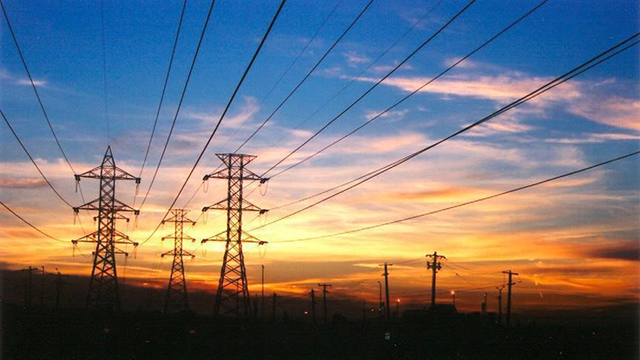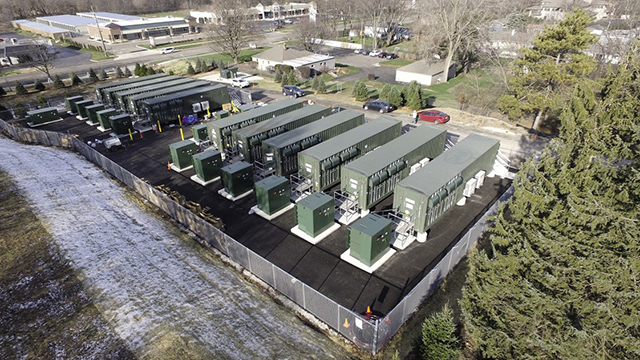
The European Bank for Reconstruction and Development (EBRD) – a traditional supporter of projects in Turkey and the region – has reiterated its commitment to continue financing Turkish renewable projects.
“EBRD will continue to support Turkish renewable projects. We recently signed a loan agreement with Borusan for the capacity extension at the Kiyikoy wind farm located in northwestern Turkey,” said EBRD director of Energy Eurasia for Sustainable Infrastructure Group, Aida Sitdikova, in an exclusive interview with Daily Sabah, on the sidelines of the Atlantic Council – EBRD Renewable Energy Outlook conference last week in Istanbul.
In January, Turkey’s Borusan and EBRD inked a $37 million financing deal for the development, construction and operation of an additional capacity of 72 megawatts (MW) to the currently operating 28 MW wind farm located on the west coast of the Black Sea province Kırklareli, Sitdikova said. The Industrial and Commercial Bank of China (ICBC) Turkey also provided the same amount of loans for the project. The extension of the Kiyikoy wind power plant project highlights Turkey’s commitment to add another 10,000 MW to its existing 7,600 MW wind power capacity in the next decade. The Kiyikoy extension project is estimated to help save annually around 99,700 tons of carbon emissions, according to the EBRD.
“Supporting Turkey’s sustainability goals is among the EBRD’s priorities in the country. To date, the bank has financed, both directly and through local banks, nearly 3,000 MW of Turkey’s installed capacity, Sitdikova said.
Talking about the possible scenarios for the post-2020 renewable energy projects investment scheme, Sitdikova said the Turkish market does not require subsidies any more given the prices.
“It (the post-2020 investment mechanism) might still be a feed-in-tariff scheme. But with the prices at the current levels in countries such as Uzbekistan or Kazakhstan, Turkey might want to take another look at the feed-in-tariff levels. Because, for instance, solar power plants projects in Turkey do not need the subsidies that have been provided so far,” Sitdikova remarked.
The EBRD Eurasia energy director noted that Uzbekistan awarded in October 2019 the United Arab Emirates’ (UAE) Masdar Clean Energy a 100 MW solar power plant project, at an auction where the price was set at $0.0267 (2.67 cents) per kilowatt-hour (kWh). Italian oil and gas producer ENI won a tender bid to build a 50 MW solar power project in Kazakhstan with an auction price set at $0.032 kWh (3.2 cents) in December 2019. When prices for solar and wind reach grid parity with conventional generation in light of the dramatic decline in the cost of renewables globally, Sitdikova explained, governments don't have to provide subsidies.
In an emphasis on Turkey’s “impressive depth and variety” in the renewables sector, she maintained that the country is well-positioned to reap the benefits of prices well below the current feed-in-tariff levels, similar to the newcomers in Central Asia and the Caucasus, if it fully enforces the competitive market forces and enables the regulatory environment.
“For countries to realize the low prices, driven by the ramped-up capacity and competition by manufacturers and suppliers, competitive procurement of renewable energy needs to be introduced,” Sitdikova emphasized and drew attention to global transition toward auction models from feed-in-tariffs with their implicit subsidies.
Turkish authorities have previously announced that the post-2020 investment scheme will be based on feed-in-tariffs but prices for wind and solar power projects will be different, without providing much detail so far.
The international trend of the last couple of years has proved that the auction model will be maintained as the pivotal financing and investment mechanism for cost-effective renewable projects as private companies have been fast-learners. The latest renewable energy report of the International Energy Agency (IEA), released in December, has argued that government support for the utility-scale renewable technologies are transitioning toward competitive auctions for which long-term purchasing agreements are devised. In its five-year forecast, IEA predicts that by 2024 two-thirds of utility renewables will be auction-based competition.
“Government subsidies might have been useful in kick-starting the renewable energy sector and catalyzing investments, but today renewables are becoming fully cost-competitive with fossil-fuel generators, even without factoring the cost of carbon,” Sitdikova further explained.
Source: Daily Sabah

Turkey's electricity production increased by 0.57% in December 2019, compared to the same month last year, according to the latest data revealed by the country's energy watchdog.
Total electricity production rose to approximately 25,757 million kilowatt-hours (kWh), from 25,612 million kWh in December 2018, Turkey's Energy Market Regulatory Authority (EMRA) announced in its electricity market report for December.
Turkey produced its electricity from several resources; 24.77% from natural gas, 23.81% from import coal and 19.76% from hydropower. Lignite, wind, geothermal, biomass, hard coal, asphaltite, fuel oil, solar and diesel generated the remaining share.
Consumption in the industrial sector saw the biggest share at 43.20%, followed by the commercial sector with 27.25%. Residential consumption ranked third with 24.8%, while agricultural irrigation and street lighting accounted for the remainder.
Turkey's installed electricity capacity was up 2.13% in December 2019 from the same period of 2018. Natural gas power plants comprised 30.53%, while 24.30% came from hydropower plants and 11.89% from lignite power plants.
Imported coal, hydro, wind, geothermal, hard coal, fuel oil, biomass and solar power also contributed to Turkey's installed capacity.
Source: AA

The global market for blockchain applications in remote and grid-connected microgrids is set to expand by 67.8% between 2019 and 2028, according to Navigant Research.
Revenue generation is expected to reach over $1.2 billion per annum.
Other key study findings include:
Europe and North America are early centres of development and pilot deployment for blockchain applications in microgrid systems. The two regions will remain market leaders despite strong growth in Asia Pacific.
Microgrid vendors and energy blockchain vendors are exploring use cases that tie the two technologies together.
Blockchain remains an emergent technology, however, is expected to play a huge role in addressing key pain points related to the financing and operations of grid-connected and remote microgrids.
Johnathon de Villier, a research analyst with Navigant Research, said: “For grid-connected microgrids, low friction, smart contract-driven transactions can open new revenue streams for service providers, aggregators, and distributed energy resources (DER) owners – and potentially play a future role in grid automation.
“In remote microgrids, blockchain-based models for asset finance and ownership can help fund microgrid deployments for energy access and create a foundation for future investment.”
Source: Smart Energy International

Recently we reported on the dire need for grid resources, especially in communities that have felt the effects of bushfires, floods and extreme weather conditions.
Experts have made it well known that the grid needs an expansion of infrastructure and further stability, in order to ensure Australia’s electricity network is able to remain sufficiently operational.
The problem now is that, according to a report from the Energy Security Board, the grid is now labelled as “critical”. As an annual checkup on the wellbeing of the grid, the body said that the force of weather conditions and natural disasters over the summer is continuing to age our coal-fired sources. These are now stretched to their absolute capacity.
The Board also noted that despite the uptake in renewables and consumer bills dropping considerably, switching over solar and wind has brought around new problems. With the lack of support towards replacing the ageing grid, it’s not yet able to safely and sustainably transport energies.
In order for Australia to take advantage of new sources of electricity generation – such as panels that can absorb power when the sun isn’t out – the grid still needs to be upgraded.
The New Daily also reported that EY Oceania leader of power and utilities Matt Rennie said that it was “blindly obvious four years ago” that there would be an issue with the uptake vs. existing infrastructure.
He added: “Therefore, the amount of renewables in the system was fully known…now the regulators are saying we have a problem.” The real issue, he said, is what we do from here – what action we decide to take.
“Really, there’s two paths: The first is to start to look at technologies that can improve the security and reliability of the grid,” Rennie said.
On top of this, he pointed out that the question should still be focused on why this isn’t already taking place.
Australia needs to rapidly redesign its infrastructure and market so that providers are given enough incentives to sell battery and gas solutions. Currently, according to Mr Rennie, there is a lack of rewards for “providing small amounts of energy on an intermittent basis into the system.”
He explains that for the market to be viable, those producing electricity need to be paid for what they’re generating and compensated for when they’re really needed in times of crisis and extreme demand.
“If we don’t fix it, the lights will go out for short periods of time.”
Source: Energy Matters

British companies are lagging far behind their European neighbours in low-carbon investment after contributing only 3% of the continent’s €124bn (£104.2bn) green spending last year. A report has revealed that German-listed companies invested 11 times more in low-carbon investments such as electric vehicles, renewable energy and smart energy grids than UK firms.
London-listed companies spent €4bn on green research and technologies compared with €44.4bn from German groups, including the carmaker Volkswagen, which invested more than a third of Europe’s total low-carbon spending in 2019. The report, from the climate disclosure organisation CDP, said Germany, Spain and Italy topped the company league table for low-carbon investment last year while the UK finished sixth, below France and Denmark.
The report, which was co-authored by the global management consulting firm Oliver Wyman, reflected well on countries that are home to major manufacturers and utilities that have made heavy investments in electric vehicles and renewable energy projects in the last year.
By contrast, UK companies did not fare as well in the investment rankings because much of the country’s green infrastructure spending is outsourced to foreign companies, including Spain’s Iberdrola, the owner of the Scottish Power, and the Danish wind power giant Orsted. The report warned that despite the €124bn investment in green solutions across the continent, low-carbon spending will need to double if Europe hopes to meet its climate targets.
On average, companies included in the report dedicated about 12% of their annual spending to low-carbon technologies but this will need to rise to 25% to help create a carbon-neutral Europe.
UK and EU leaders have agreed to be climate neutral or net zero by 2050 in a bid to keep global temperatures from climbing to levels that could lead to catastrophic climate chaos. Steven Tebbe, the managing director of CDP in Europe, said achieving this goal means that Europe’s economy needs to cut its emissions at the rate of nearly 8%, which requires “a fundamental transformation of our economic business model”.
He said: “The investment decisions taken by European companies and their owners will make or break whether we are successful – and they need to double down.”
The report found that almost 900 listed European companies invested a total of €59bn in new low-carbon capital investments and €65bn in research and development last year.
The biggest areas of new investment were in research and development of electric vehicle technologies, which reached €43bn across Europe, and capital investment in renewable energy which reached €16bn. Investment in energy grid infrastructure and smart energy technology climbed to €15bn and €8bn respectively.
“Across many types of investment, the business case for transitioning businesses on to a low-carbon pathway is clear and the opportunities vast,” Tebbe said. The CDP estimates that the potential value of Europe’s new low-carbon business opportunities could reach €1.22tn – more than six times the €192bn of green investment required to realise this financial benefit.
“But overall current investment levels are still short of putting European firms on track for net zero emissions,” he said.
“For industries where decarbonisation is more challenging, there is a serious need for financial markets and policymakers to create better conditions for low-carbon investment and deliver stronger incentives to drive investment into breakthrough technologies, where capital expenditure is often high and returns long-term.”
Source: Guardian

As the sector continues to grow rapidly, delays in manufacturing scale-ups, difficulties sourcing raw materials and a separate path taken by the electric vehicle sector could all chuck ‘sand in the gears’, according to analyst Wood Mackenzie.
Despite a slowdown in price declines the global energy storage market is set to grow from around 4 GW of annual deployments last year to more than 15 GW in 2024, according to U.S.-owned market intelligence company Wood Mackenzie. As the market matures, the analyst predicts, the focus will shift from rapidly falling costs to a true recognition of the technology’s value in the global energy transition.
“The energy storage industry is in the enviable position of juggling growth game-changers from multiple directions,” said Daniel Finn-Foley, head of energy storage at WoodMac. “Plunging costs drove speculation in the first scaled markets but as price declines enter a steadier rate, further recognition of storage’s value – rather than cost – will be the key factor in determining growth.”
In the next decade, WoodMac expects to see the already consolidating web of energy storage manufacturers, developers, investors and integrators compete for their slice of the pie, carving out mature supply chains and propelling cost reductions. As they do, continued policy and regulatory efforts will be key to driving upside in the market.
As one of the major forces behind the energy transition, corporate behemoths such as Microsoft, Google and Facebook are developing a keen interest in storage, blazing a trail for other companies seeking to offset emissions. With businesses more eager than ever to make bold clean energy promises, last year saw 19.5 GW of solar and wind power purchase agreements signed by more than 100 corporations in 23 countries, according to data from business intelligence firm Bloomberg New Energy Finance.
Google last month unveiled a major solar-plus-storage deal with Nevada utility NV Energy in a bid to meet its real-time energy needs from renewables rather than offsetting the electricity it consumes. Shortly after, German carmaker Daimler announced a deal with Norwegian power firm Statkraft to deliver 24/7 renewable electricity to the automotive giant’s German sites.
According to WoodMac, such deals exemplified a new approach to clean power from corporations. “If this catches on among other climate-forward corporations, the upside could be huge,” said Finn-Foley.
French oil major Total and French-owned German auto company Opel announced a collaboration on electric vehicle (EV) cell manufacturing this year, potentially investing as much as $5.5 billion in up to 47 GWh of manufacturing capacity. “Total, already investing in stationary storage applications, and Opel, clearly see batteries as a key element of the future,” said Finn-Foley.
On top of that, major battery initiatives have already been set in motion, such as the European Commission’s €10 billion ($10.9 billion) innovation fund for low-carbon technologies and the U.S. Department of Energy’s Energy Storage Grand Challenge – the federal government’s most ambitious storage initiative to date.
However, the drive towards renewable technologies, including energy storage, cannot happen without investment. The World Bank and the Asian Development Fund offered to lower-income nations by the Asian Development Bank have already begun reshaping the relationship between finance and clean tech. Meanwhile, U.S. investment titan BlackRock has vowed to exit coal as part of a climate-focused strategy.
“Storage has emerged as a potential focal point for the focus on sustainability, with significant investment from a new multi-billion [-dollar] renewable energy fund set to flow into the storage space,” added WoodMac’s Finn-Foley.
While the storage industry is gathering momentum, WoodMac has pointed out recent years have been marked by delays caused by safety concerns and said they are the inevitable logistical hiccups that occur when transitioning from pilot to large scale amid uncertain market regulations.
The stationary energy storage market has the “benefit and complication” of having a supply chain which overlaps with the EV and consumer electronics industries. According to Finn-Foley, securing adequate supply to meet growing demand is an immense challenge and uncertainty goes even further up the chain, encouraging vendors to pursue alternative battery chemistries or push towards low-cobalt systems.
Source: pv magazine
The Economic Toll of the Coronavirus – from iPhones to Solar Panels to Tourism
COVID-19 has potentially serious implications for the global economy. Apple revised its revenue guidance, due to a slowdown at manufacturing sites in China as well as reduced demand by Chinese consumers. The spreading coronavirus is taking a toll on economic players around the world, from farmers and ranchers in the Americas to manufacturers of solar panels in India to tourism workers across Asia.
Please click here to read the full report.
Solar Istanbul 2020
March 11 - 13 / Istanbul
3rd International Forum Energy for Smart Mobility
March 31 - April 01 / Marseille
InnoGrid2020+ Conference
May 05 - 06 / Brussels
23rd World Hydrogen Energy Conference
July 05 - 09 / Istanbul
4th International Conference on Energy Research and Technology
August 19 - 21 / Praque

